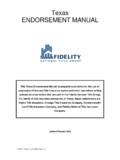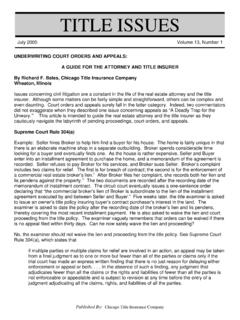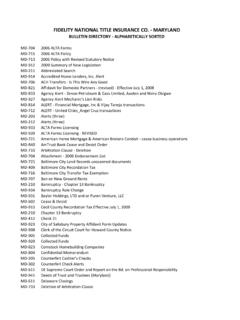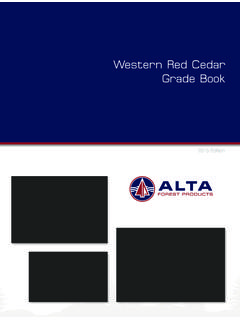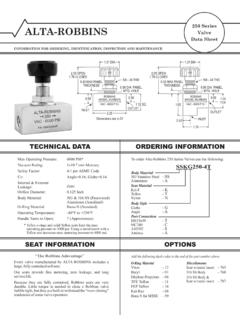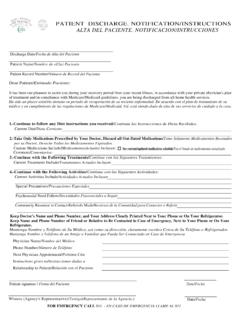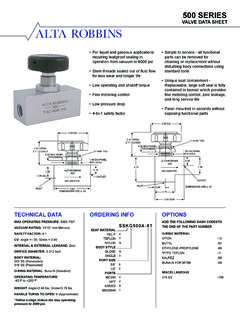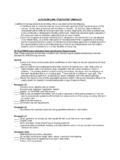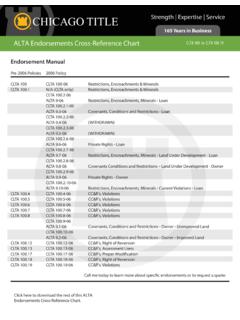Transcription of THE 2006 ALTA POLICY FORMS AND …
1 THE 2006 ALTA POLICY FORMS AND ENDORSEMENTS: THE NEW TITLE POLICIES By Douglas M. Karlen, Regional Counsel Chicago Title Insurance Company The American Land Title Association (ALTA) has adopted new title insurance POLICY and endorsement FORMS , effective June 17, 2006. This article will describe the new owner and loan policies (hereinafter referred to as the 2006 policies) and compare their coverages to the 1992 POLICY FORMS currently used by all title insurers in the Midwest. It will also contain a brief description of the new ALTA endorsements. In highlighting differences in coverages, this discussion assumes that the reader is already familiar with the provisions of the 1992 POLICY FORMS . Further, it will not contain quotations of text from either the 1992 or the 2006 policies. The 2006 policies and endorsements may be inspected and downloaded from the ALTA website at GENERAL PRINCIPLES Several general principles may be discerned from the format and language of the 2006 policies.
2 First, the 2006 policies contain new terms and new or revised definitions. ALTA made these changes to accomplish three purposes: (a) to more accurately describe matters covered by the POLICY (matching the style of the ALTA residential POLICY FORMS ); (b) to streamline language throughout the policies, but especially in the Conditions section; and (c) to expand coverage (see , the expanded definition of Insured in the 2006 owner s POLICY and the new definition of Indebtedness in the 2006 loan POLICY ). Second, the 2006 policies specify as covered risks many matters that traditionally have been viewed as covered by predecessor policies though not specifically mentioned in predecessor POLICY language. For example, the title industry has always viewed fraud and forgery as covered risks. Yet, the 1992, 1990, and 1970 POLICY FORMS do not include the words fraud and forgery.
3 The 2006 policies now specify fraud and forgery as covered risks. See Covered Risk 2(a)(i) on both the 2006 owner s POLICY and the 2006 loan POLICY . Under this general principle, the 2006 policies match the style of ALTA residential POLICY FORMS by more descriptively designating matters covered by the POLICY . Third, in the 2006 policies, ALTA eliminated exceptions, or limitations, from the Exclusions from Coverage section. From the Insured s point of view, affirmative insuring provisions (Covered Risks in the 2006 policies) should be positives (+), while exclusions from coverage should be negatives (-). Yet, the 1992 and predecessor policies contained exceptions to the exclusions (- and -). Apparently, some courts failed to consider that two negatives equal a positive and insisted that coverage must appear in affirmative language.
4 ALTA revised the POLICY language to clarify that coverage indeed exists. See , how the 2006 policies handle the traditional exclusion for violations of zoning and building codes in Covered Risk 5 and Exclusion 1(a). This new principle may be illustrated as follows: 1992 and predecessor policies: violations are not covered unless notice appears in public records and are not otherwise excepted on Schedule B. 2006 POLICY : violations are covered if notice appears in public records and are not otherwise excepted on Schedule B. Thus, a Covered Risk must always be read together with a matching Exclusion and any related exceptions on Schedule B. Fourth, the 2006 policies provide certain standard coverages in an automatic, or default, mode. For example, both 2006 policies automatically provide survey coverage under Covered Risk 2(c).
5 This coverage may only be modified or eliminated by Schedule B exception. Thus, if the title insurer receives a survey and, upon examining it, discovers an encroachment or other adverse matter, the title insurer will automatically provide coverage over the matter unless it notes the matter in a Schedule B exception. If the insurer is not willing to provide the Insured with survey coverage of any sort ( , when no survey is furnished in a complex commercial transaction), then Covered Risk 2(c) must be neutralized by Schedule B exception. Fifth, the 2006 loan POLICY specifically accommodates mortgages in electronic form . See , the definition of Mortgage in Condition 1(h). Finally, the 2006 policies provide expanded coverages. Claims administrators must become familiar with the new or revised provisions because many of them relate to the claims handling process.
6 NEW TERMS AND DEFINITIONS Sections of the POLICY The affirmative insuring provisions of the 1992 and predecessor policies never had a name. In the 2006 policies, they bear the name Covered Risks. The Exclusions from Coverage, Schedule A, and Schedule B retain their traditional names. The Conditions and Stipulations, however, have been renamed as Conditions. 2006 Owner s POLICY Definitions: Condition 1 Some of the new or expanded definitions include the following: Title means the estate or interest described in Schedule A. This is convenient shorthand that streamlines language throughout the POLICY . Condition 1(j). Unmarketable Title has a revised and expanded definition. Under the 1992 POLICY , unmarketability of title was limited to a prospective purchaser of the land who, by reason of a covered matter, could terminate without liability a contract requiring seller to deliver marketable title.
7 The 2006 POLICY expands the definition to include prospective lessees of and lenders on the Title. Condition 1(k). Insured has been redefined. Under the 2006 POLICY , the term includes everything contained in the 1992 definition--but with more specificity. In addition, the 2006 POLICY includes the following as the Insured: a grantee in a deed executed by the Named Insured and delivered for no consideration if the grantee: (1) is wholly owned by the Named Insured; (2) wholly owns the Named Insured; (3) is wholly owned by an affiliated entity of the Named Insured, provided the affiliated entity and the Named Insured are both wholly owned by the same person or entity; or (4) is a trustee or beneficiary of a trust created by a written instrument established by the Named Insured for estate planning purposes. Condition 1(d)(i)(D).
8 Item (4) is a significant addition to coverage. It eliminates the need for an assignment of POLICY or for an endorsement substituting Named Insureds whenever the Named Insured conveys the subject land to an estate planning device. The term Insured also includes successors upon the conversion of a Named Insured entity to another kind of entity. Condition (1)(d)(i)(C). Presumably, this provision eliminates the Fairway problem and renders requests for the Fairway endorsement unnecessary. Amount of Insurance now includes the amount shown in Schedule A and also any increases or decreases provided for in endorsements or through the operation of various provisions in the Conditions. Condition 1(a). All other definitions in the 2006 owner s POLICY provide the same coverage as the 1992 definitions. The language of most has changed, however, to accommodate new definitions and re-numbered POLICY provisions.
9 2006 Loan POLICY Definitions: Conditions 1 Two new definitions merit attention because they add new coverage. Insured has been redefined. Under the 2006 loan POLICY , the term includes everything contained in the 1992 POLICY . In addition, the 2006 POLICY includes as an Insured successors in ownership of the indebtedness, whether the successor owns the indebtedness for its own account or as a trustee or other fiduciary. Condition 1(e)(i)(A). The term also includes the successor to an Insured upon conversion to a different kind of entity. Condition 1(e)(i)(D). The term Insured also includes the grantee in a deed executed by the Named Insured (after acquisition of the Land by foreclosure or deed in lieu of foreclosure) and delivered for no consideration if the grantee: (1) is wholly owned by the Named Insured; (2) wholly owns the Named Insured; or (3) is wholly owned by an affiliated entity of the Named Insured, provided the affiliated entity and the Named Insured are both wholly owned by the same person or entity.
10 Condition 1(e)(i)(E). Finally, the term Insured also includes the person or entity who has control of the transferable record, if the Indebtedness is evidenced by a transferable record, as these terms are defined by applicable electronic transactions law. Condition 1(e)(i)(B). This language was added to include third parties, such as MERS, or other service providers, even though the third party may not be named when an electronic transaction is involved. Unlike predecessor policies, the 2006 loan POLICY defines the term Indebtedness. In the process of defining 3the term, the 2006 loan POLICY expands coverage by specifying the elements of indebtedness that will be considered in measuring loss under the POLICY . Broadly stated, Indebtedness means the obligation secured by the insured mortgage. Condition 1(d).

